Railroad Stations Across The USA
Last revised: February 27, 2025
By: Adam Burns
American railroad stations used to be an all too common sight throughout the country as nearly every town, large or small, contained at least one.
During a bygone era when trains handled virtually all interstate and intrastate transportation these facilities were a vital need.
Before the days of UPS and FedEx, the best way to ship parcels was through the Railway Express Agency, which provided door-to-door service throughout the continental U.S. Once packages arrived at local depots (or large terminals) the on-duty agent would personally deliver it.
Station construction culminated between 1910 and 1913 when arguably the two most spectacular opened on New York City's Manhattan Island, Pennsylvania Station and Grand Central Terminal.
Background
As rail travel waned and the shipping industry turned to other modes many stations met the wrecking ball while REA quietly disappeared.
It culminated with the loss of a Penn Station's above-ground terminal during the 1960's. Perhaps architect Vincent Scully articulated it best when he famously stated after the station's demise, "One entered the city like a god. One scuttles in now like a rat."
Photos
 Union Pacific's beautiful station in Cheyenne, Wyoming, circa 1984. The facility was built in the Richardsonian Romanesque style during the 1880s featuring sandstone quarried near Fort Collins, Colorado. Mike Bledsoe photo. American-Rails.com collection.
Union Pacific's beautiful station in Cheyenne, Wyoming, circa 1984. The facility was built in the Richardsonian Romanesque style during the 1880s featuring sandstone quarried near Fort Collins, Colorado. Mike Bledsoe photo. American-Rails.com collection.History
Our country's first common-carrier, the Baltimore & Ohio, is also credited with establishing two of the earliest known train stations in this country.
In May of 1830 it inaugurated service between a small depot at Ellicott's Mills, Maryland (now known as Ellicott City) and its then-primary stop in Baltimore, Mount Clare.
Both structures are preserved today, recognized as National Historic Landmark's due to their age and economic importance.
The classic train station was a true work of art, crafted in a variety of mediums (brick, wood, stone, marble, etc.) as architects maintained a constant eye towards opulence and beauty.
There were several styles utilized, depending upon the region (Victorian, for instance, was often found in the Northeast/New England while Spanish Revival normally appeared in the Southwest). Many are covered in more detail below.
As Brian Solomon notes in his book, "Railway Depots, Stations & Terminals," during the industry's "Golden Age" (through World War I) it is estimated 80,000 depots or terminals were in service!
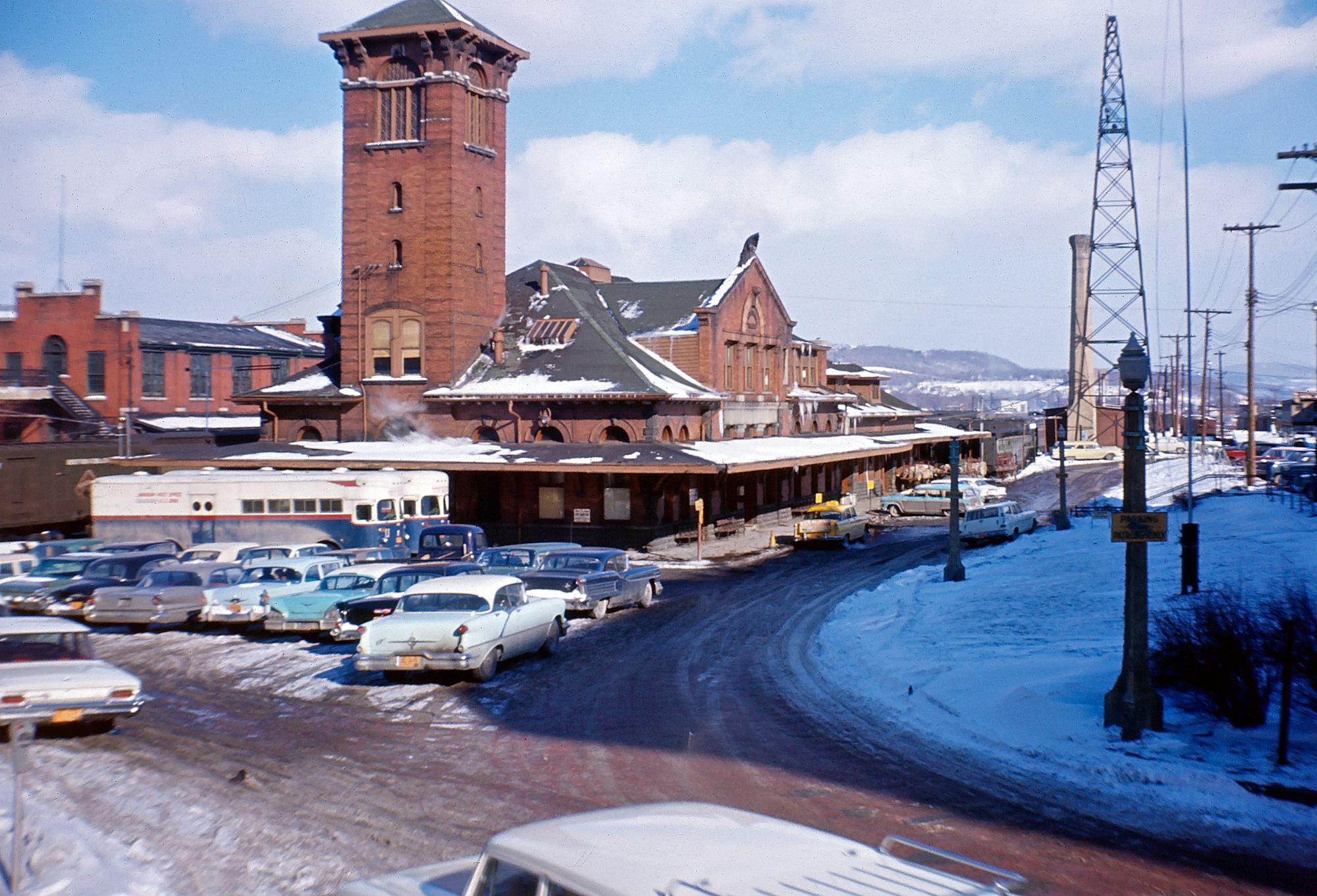 The former Lackawanna station in Binghamton, New York during the early Erie Lackawanna era, circa 1960. The building, completed in 1901 in the Italian Renaissance style featuring a campanile (bell tower), still stands today, restored. American-Rails.com collection.
The former Lackawanna station in Binghamton, New York during the early Erie Lackawanna era, circa 1960. The building, completed in 1901 in the Italian Renaissance style featuring a campanile (bell tower), still stands today, restored. American-Rails.com collection.The grand buildings we remember so well today, places like Los Angeles Union Passenger Terminal, Chicago Union Station, Grand Central Terminal, Boston's South Station, and Seattle's King Street Station often receive the greatest attention in literally circles.
However, it was the small town depot that truly kept America humming. Until the age of the automobile, widespread use of the household telephone, and development of the airliner the depot was a town's lifeline; for so many communities these facilities provided the only connection to the outside world.
It was quite common to see folks mingling around a local train station at all hours of the day awaiting incoming news. As Hans and April Halberstadt point out in their book, "The American Train Depot And Roundhouse," the physical building was not only used for passengers but also staffed an agent/operator.
In an age before telephones or wireless communication this person was essential in keeping train movements safe and efficient.
In such territory not protected by centralized traffic control (CTC) or some other type of signaling system, trains operated by the so-called "Timetable Authority" method whereby a dispatcher held direct control over a particular segment of track.
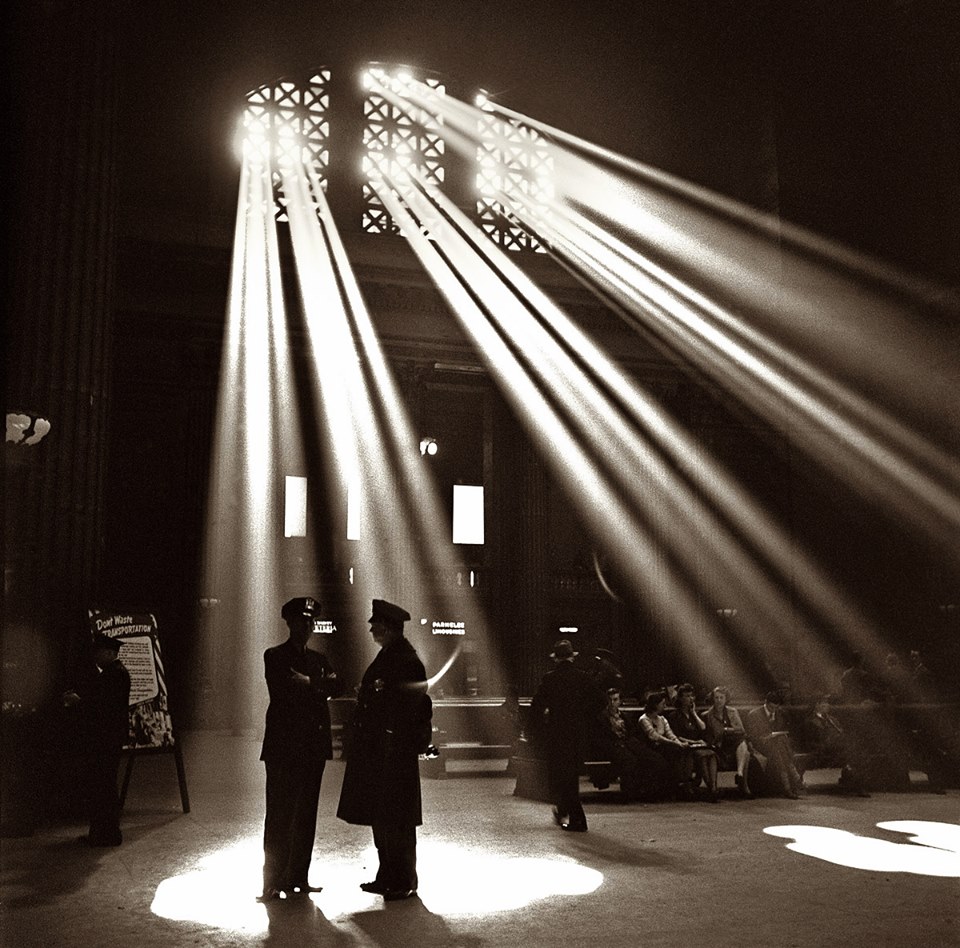 In another fabulous use of shadow and light, legendary photographer Jack Delano captured sunbeams filtering into Chicago Union Station's waiting room during the height of World War II in January of 1943.
In another fabulous use of shadow and light, legendary photographer Jack Delano captured sunbeams filtering into Chicago Union Station's waiting room during the height of World War II in January of 1943.While a dispatcher knew where a train should be at any particular time the train station operators/agents would report (via telegraph, and later telephone) when trains had reached their location using a two-letter identification specific to each depot (the so-called "OS" or "On Sheet" report).
In addition, if orders were required the agent/operator would write these down (received by a telegraph from the dispatcher) then hand them up on the fly using a large hoop (sometimes permanently mounted near the tracks).
Both the head-end crew (usually the fireman) and those in the caboose (typically the flagman) received these "nineteen" orders, often referred to as "flimsies" (there were also "thirty-one" orders which required the train to physically stop and the engineer sign off on the directive). The operator always made at least three copies (office, engineer [head-end], and conductor [caboose]).
This helped ensure redundancy, safety, and that the orders were clearly understood. It became a true skill for crewmen to grab these, at-speed (misses were rare but did occur!). Within an industry that sometimes changes little over many decades issuing orders in this manner survived well into the 1980's.
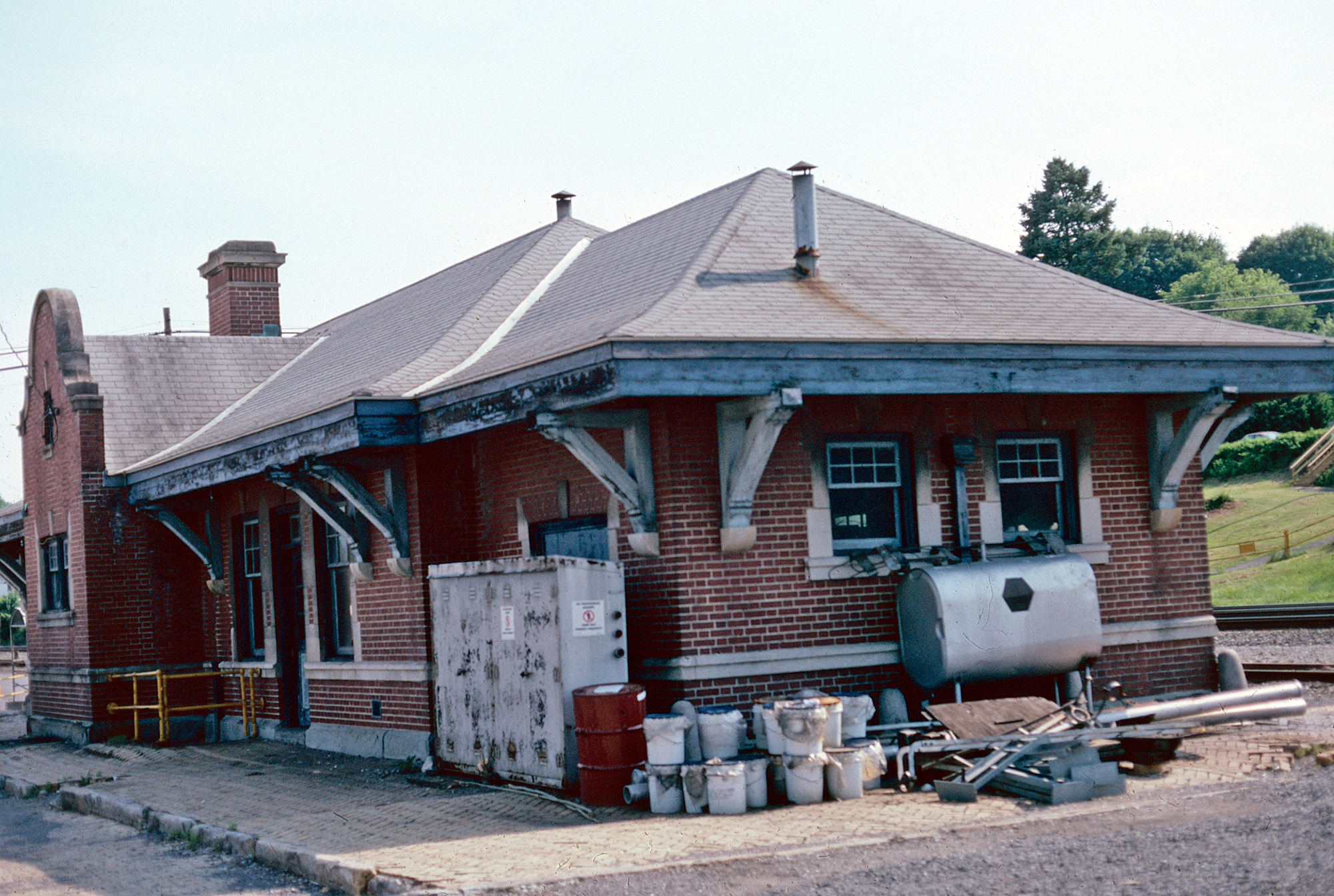 The former Pennsylvania Railroad depot in Mifflin, Pennsylvania is seen here in June, 1996. American-Rails.com collection.
The former Pennsylvania Railroad depot in Mifflin, Pennsylvania is seen here in June, 1996. American-Rails.com collection.In the Halberstadt's book they interviewed former Southern Pacific station agent Dick Maurer who described in more detail the hoop system:
"'Originally, train orders were passed up on a bamboo hoop,' Dick says, 'then later, on a Y-shaped bracket on a pole beside the track.
The order was attached to a loop of string clipped to the bracket; the fireman put his arm out of the cab of the locomotive and snagged the loop as they went by. Sometimes they missed, and then the train had to stop and he'd have to walk back to get the order.'"
Depots were also equipped with a semaphore system, controlled by the operator, which informed the inbound crew if orders were to be received. Each railroad had their own system but, generally, if the blade was in the vertical position a train could proceed.
However, if horizontal orders were in order! As the 20th century progressed some depots updated this with a modern, lit system featuring green, yellow, or red lights. To learn more about these train order signals please click here.
Aside from an operator a depot almost always held offices for the Railway Express Agency. In his book, "Ten Turtles To Tucumcari," Klink Garrett describes what it was like to work as an agent at REA where he was employed from 1935 until 1972, witnessing both its greatest prosperity and final days.
The company's red diamond logo could be found on nearly every depot, which always included its own delivery truck (decorated in deep forest green) for local shipments.
Even depots in extremely rural locations, such as the Chicago, Burlington & Quincy's facility at Hot Springs, South Dakota were staffed.
In some extremely out-of-the-way communities, such as Shoshoni, Wyoming there was not even a depot but nevertheless one could find an REA agent. In this case they were holed up in Burlington's local section house and even had a delivery truck (with an accompanying garage) to pick up packages from nearby rail sidings.
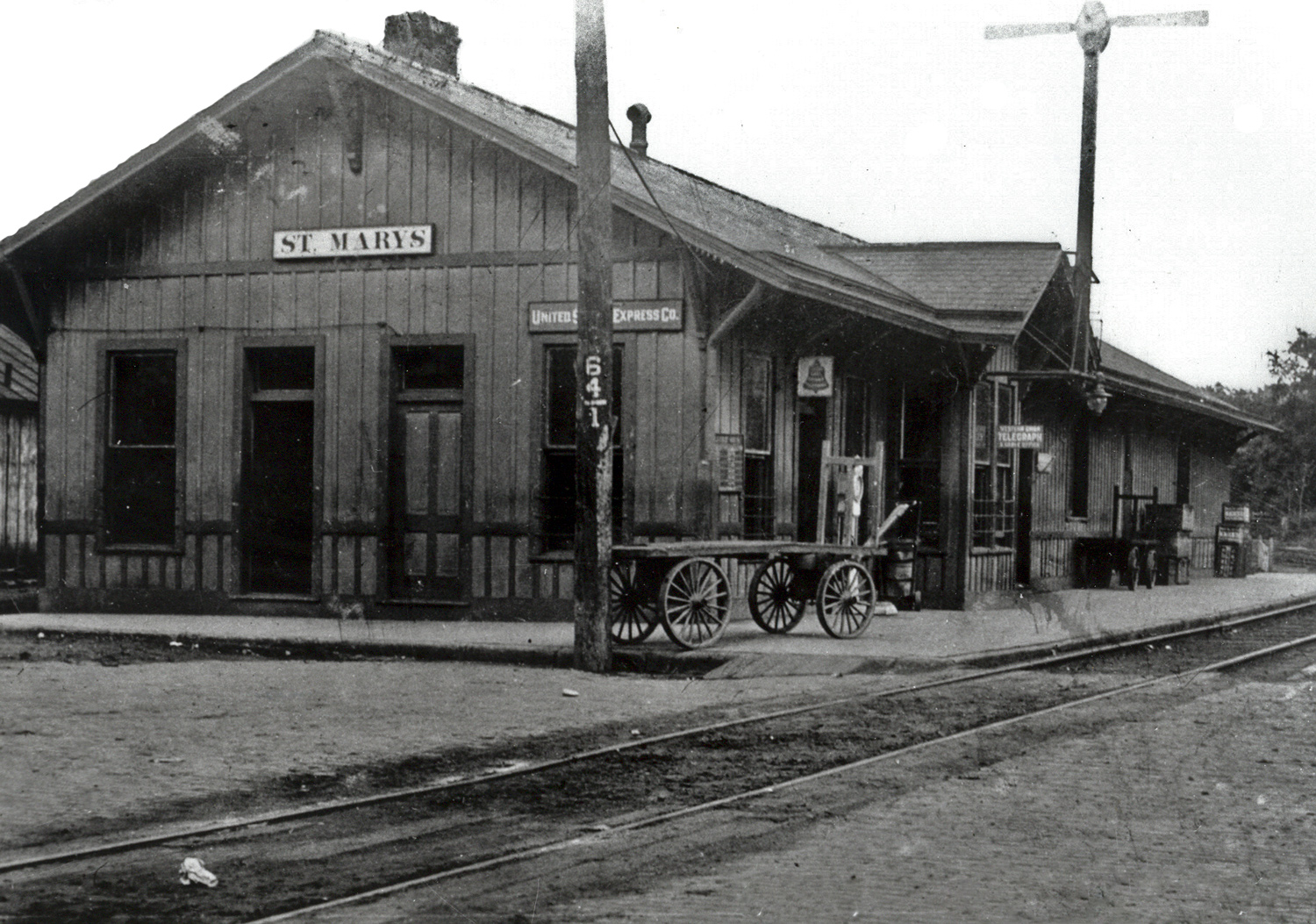 Seen here is the small town depot in St. Marys, West Virginia during the early 1900s. The building was razed in the 1960s. Author's collection.
Seen here is the small town depot in St. Marys, West Virginia during the early 1900s. The building was razed in the 1960s. Author's collection.Depots, Train Stations Or Terminals?
The term "train station" is generally described as the physical building where passengers boarded and departed from their train. However, the railroad actually defined a "station" as a stopping point that may, or may not, contain a building.
These locations could feature anything from a customer or water tank to a siding or simply a sign. The "depot" was the nomenclature regularly reserved for small facilities while "terminal" often described the very large structures such as Grand Central Terminal, Boston's South Station, or Chicago's Dearborn Station.
There was also the term "union station," detailing those buildings used/shared by at least two or more railroads. It ranged from one no larger than a typical depot to Chicago's grand Union Station.
Architecture
During the 19th and early 20th centuries architecture was very different from today's largely geometric buildings. Back then style, elegance, and appearance were as equally important as the building's function and purpose.
This was especially true with railroad stations, both large and small The largest and most spectacular also boasted a company's wealth and power, often found in the biggest metropolitan areas such as New York, Buffalo, Philadelphia, Washington, Seattle, and Los Angeles.
Alas, many would meet the wrecking ball while a few have been beautifully restored to their original appearance. Included here are many of the common architectural styles used in their construction.
Beaux Arts
Perhaps the most common style was the Beaux Arts design, which could be found employed within many large terminals, including New York's Pennsylvania Station and Grand Central Terminal. After its unveiling at the 1893 World's Colombian Exposition in Chicago it remained popular through the early 20th century.
According to Hans and April Halberstadt's book, "The American Train Depot And Roundhouse," the style was named for the French School of Design, once known as the Nationale Ecole des Beaux Arts (National School Of Fine Art).
Train stations built in the Beaux Arts style featured enormous arches, colonnades, domes, and columns to draw attention and awe.
Chateau
This style dates back to the Medieval period of France when many castles and stately buildings were erected with ornate stonework, steeply pitched roofs, and spiral peaks.
In terms of railroad architecture it was often employed as an addition or auxiliary feature, not as the primary design. The preeminent terminal built in the Chateau style was St. Louis Union Station, the work of firm Link & Cameron. It still stands today, one of the city's featured attractions.
Colonial
The Colonial design is a general designation usually referring to depots which had some type of intricate woodwork or decoration.
Historians technically refer to Colonial styles (French, Spanish, American, Dutch, German, etc.) as those built before 1800 but are occasionally used to describe small stations dressed in this manner, usually found in New England or the Northeast.
Gothic
Another style borrowed from the Medieval period stations built in Gothic Revival resembled grand, fortified castles and cathedrals with steeples, sharp roof lines, spiraling peaks, and towers.
The larger facilities were constructed in stone while smaller depots carried decorative woodwork. It was most often used in the 19th century.
Greek Revival
In large stations this style could usually be found as an addition incorporated into an overall design, such as Beaux Arts. However, many small depots carried the architecture throughout. It was meant to evoke the importance of Greek architecture, such as the magnificent Parthenon, and endures today.
Italianate
The true Italianate style has largely disappeared as no railroad structures featuring it survive. However, those of the Victorian Italianate style have persevered, providing a glimpse of this subtle but ornate architecture.
The Italianate style was first used by English architect John Nash in 1802 and borrowed from the designs of the 16th-century Italian Renaissance style. Its prominent features included an overall rectangular appearance with a flat roof line.
However, the windows were normally arched with beautiful trim highlights, including the roof. It first gained appeal in the United States prior to the Civil War and again at the turn of the 20th century (then classified as Victorian Italianate).
Mission/Mission Revival
This style was exclusive to the West and Southwest calling upon the region's history with Mexico and Central America.
Specifically, stations carrying this architecture were modeled after the California missions built along the El Camino Real by Franciscan missionaries between 1769 and 1823.
Their prominent features included a stucco, plaster, or adobe exterior with roofing made from curved tiling. In addition, prominent archways adorn all aspects of the building and include at least one quatrefoil window.
The interior usually featured some type of ceramic tiling and, on occasion, wood trim. Finally, the more prominent terminals employed a grand bell tower, such as the Santa Fe's gorgeous facility in San Diego (adorned in two), opened in 1915. The AT&SF and Southern Pacific most often constructed mission style depots.
Revival
A very general term, "Revival" often describes a reused architectural style many decades or centuries after it was first employed. Most styles mentioned here are technically revivals from an earlier period.
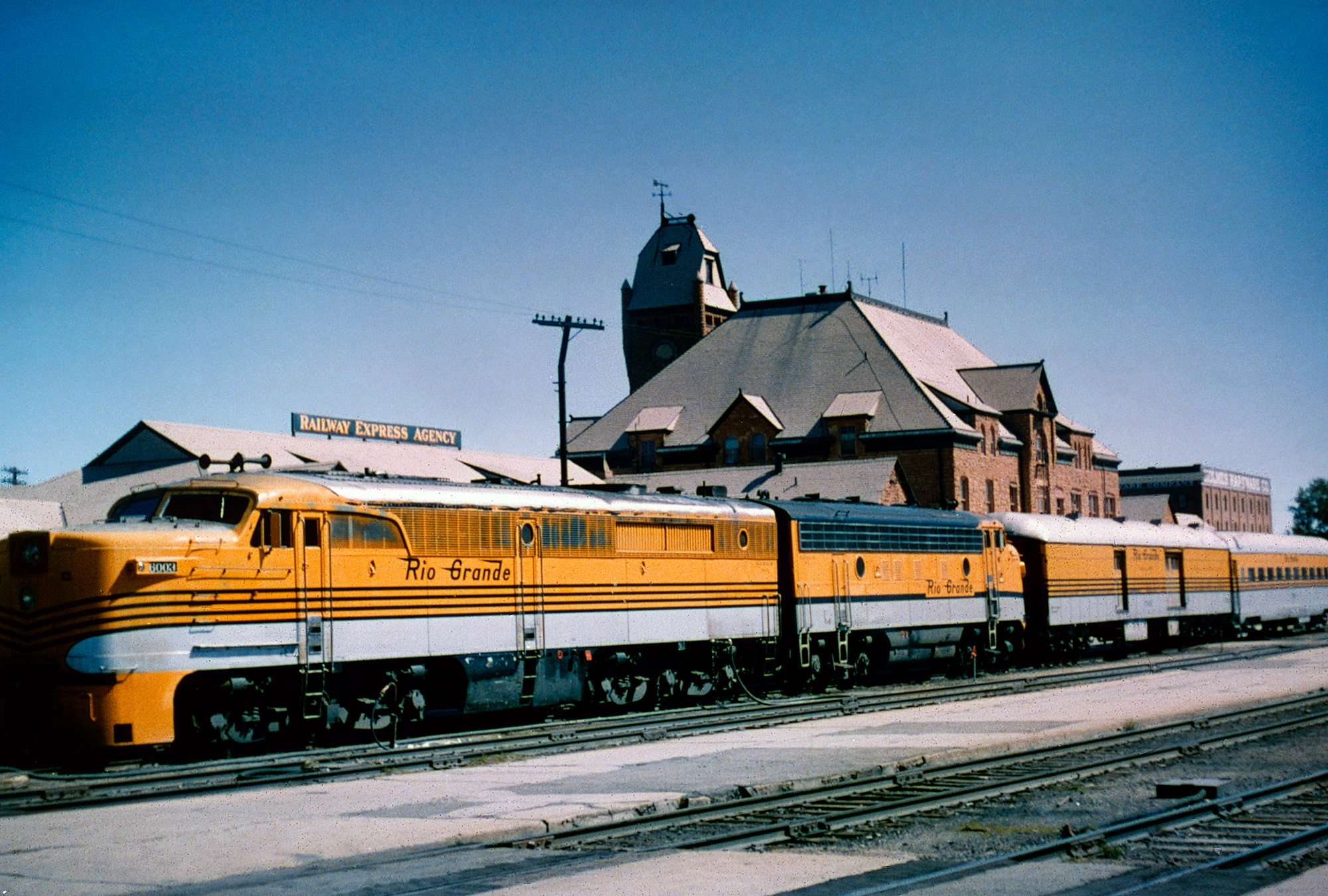 Rio Grande PA-1 #6003 and F7A #5551 are stopped in front of the beautiful Union Depot at Pueblo, Colorado with the "Royal Gorge" on October 2, 1965. This building was contracted in the Richardsonian Romanesque style in 1889–1890. It still stands today. Ed Fulcomer photo. American-Rails.com collection.
Rio Grande PA-1 #6003 and F7A #5551 are stopped in front of the beautiful Union Depot at Pueblo, Colorado with the "Royal Gorge" on October 2, 1965. This building was contracted in the Richardsonian Romanesque style in 1889–1890. It still stands today. Ed Fulcomer photo. American-Rails.com collection.Romanesque
Another popular style during the heyday of train station construction was Romanesque, sometimes referred to as Romanesque Revival.
It called upon the ancient Roman's stonework architecture that often carried arches adorned by a centered keystone at the top; domes were also widely used and everything was clad in grand stonework as the base material.
Henry H. Richardson was usually commissioned by railroads for smaller depots but he employed the Romanesque theme so often a variant style was named after him, Richard Romanesque.
Victorian
The last great architectural style was the Victorian theme, named after England's Queen Victoria when she ruled from 1837 to 1901. These depots were characterized by their grand peaks, tall clock towers, arched windows, and stone/brick masonry.
The style was similar to Gothic and also hailed from the Medieval period of great castles and cathedrals. Smaller depots were often built partially or entirely of wood while also carrying the steep roof lines and beautiful decorative touches that defined Victorian designs; the so-called "Gingerbread House" look.
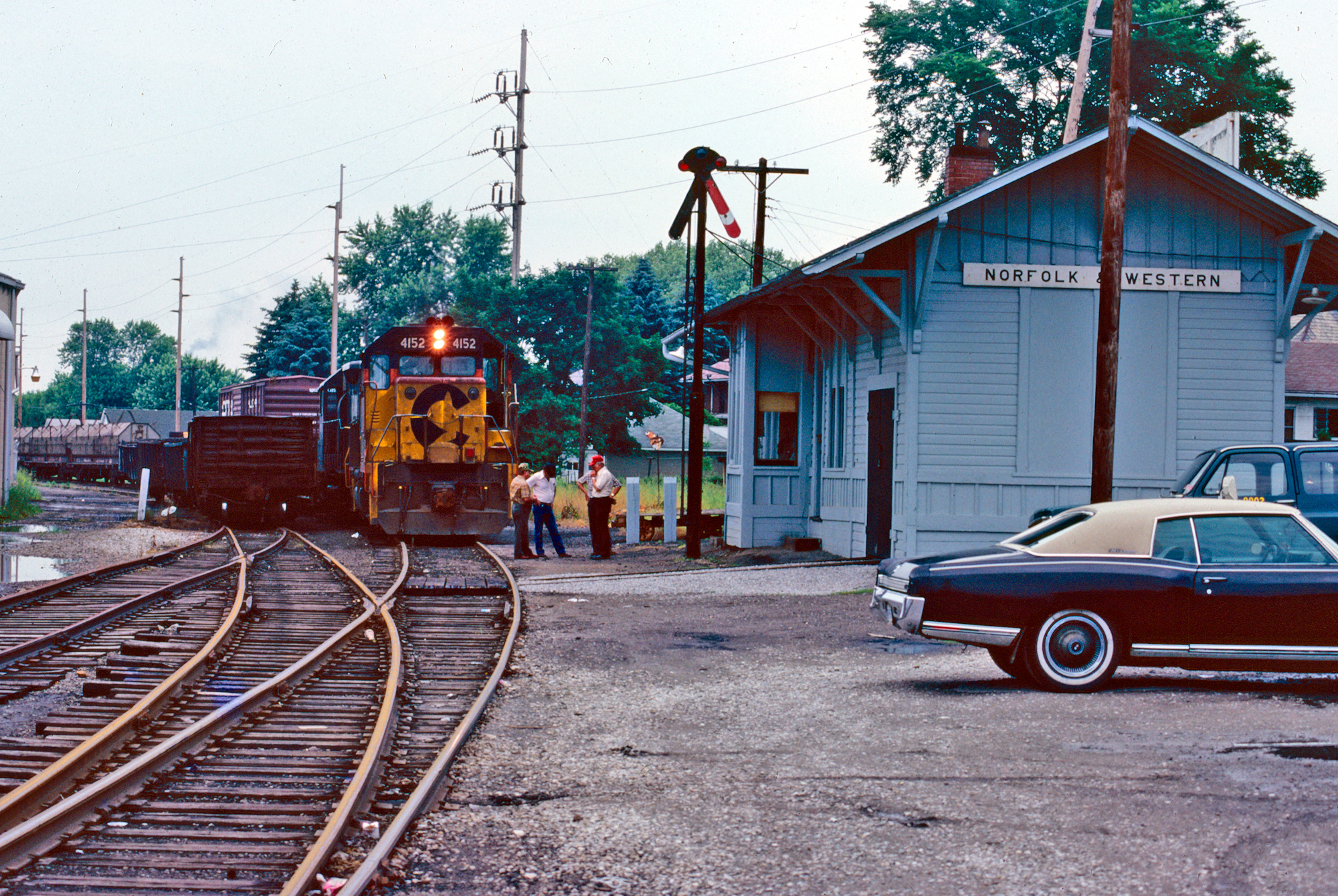 Baltimore & Ohio GP40-2 #4152 is stopped at the Norfolk & Western depot (ex-Nickel Plate) in Coshocton, Ohio as the crew chat with the agent while working local service; June, 1983. American-Rails.com collection.
Baltimore & Ohio GP40-2 #4152 is stopped at the Norfolk & Western depot (ex-Nickel Plate) in Coshocton, Ohio as the crew chat with the agent while working local service; June, 1983. American-Rails.com collection.As the automobile came of age the local depot fell from importance, declining with each passing decade after World War II. Finally, by the 1970's most small-town facilities still in use held only the local operator. As maintenance waned the buildings became dilapidated and rundown.
Even large terminals like Penn Station showed significant signs of neglect in its final years. The information listed above is a compilation of many such buildings which survive in some form across the country, broken down by state. Please by aware that unless otherwise noted the buildings highlighted describe only passenger facilities.
If interested, the Railroad Station Historical Society provides detailed information concerning all known extant structures (roundhouses, water tanks, section houses, etc.). I realize there may be corrections/additions to any of the above lists.
If you may know of any please let me know (either through e-mail or simply make a post below to the Facebook comments) and I will work to get the information up-to-date. Many thanks in advance for any bit of help you may have!
Noted Architects
There were several architects or firms that designed train stations during the 19th and early 20th centuries.
Individuals such as E. Francis Baldwin were known for smaller facilities while Mead, McKim & White conceived arguably the greatest terminal ever built, Pennsylvania Railroad's spectacular Pennsylvania Station on Manhattan Island.
Included here is a brief look at many and the prevailing styles they employed, ranging from the classic Beaux Arts to the opulent Romanesque Revival.
Bradford Lee Gilbert (1853-1911)
Gilbert was a native of Watertown, New York and held a solo practice in New York City. He is credited with scores of depots, large terminals, and related facilities.
Two of his most notable projects included redesigning New York Central's Grand Central Station in Manhattan (before it was replaced by Central Terminal) as well as drawing up Illinois Central's gorgeous Central Station in Chicago.
He began his railroad work at the age of 23 when hired as the New York, Lake Erie & Western's (Erie Railroad) chief architect in 1876. Over the years he was commissioned by many companies such as the New Haven, Reading, Boston & Maine, Jersey Central, Ontario & Western, and Pere Marquette among others.
Daniel Hudson Burnham (1846 - 1912)
An accomplished architect, Burnham predominantly designed buildings outside of the railroad industry such as Chicago's Masonic Temple Building, one of the country's first true skyscrapers.
He became partners with John Wellburn Root as part of the firm, Burnham & Root. After Root's death in 1891 the business was renamed D.H. Burnham & Company. Burnham largely worked in the Beaux Arts style with Greek and Roman themes.
His most famous work was collaborating with William Pierce Anderson in designing Washington Union Station which opened in 1908. The facility remains an important passenger terminal today.
Ephraim Francis Baldwin (1837 – 1916)
The Baltimore & Ohio hired Baldwin in 1872 as its head architect and he went on to design numerous depots, shops, and related buildings for the railroad over the next few decades across Maryland, West Virginia, and southwestern Pennsylvania.
Arguably his most famous work was at Point of Rocks, Maryland where he conceived a stunning Victorian/Gothic train station located at the point where the B&O's new and old main lines met.
With its high bell tower, decorative trim, and ornate windows it held the appearance of a bucolic church. The building still stands today.
Graham, Anderson, Probst & White
This Chicago firm was the successor to D.H. Burnham & Company through Burnham's surviving partner, Ernest R. Graham, and his sons, Hubert Burnham and Daniel Burnham, Jr.
It was originally founded in 1912 as Graham, Burnham & Company and changed to Graham, Anderson, Probst & White in 1917 when Burnham's sons left to form their own practice.
They are best known for working in the Beaux Arts style and designing Chicago Union Station. However, they were also commissioned by other railroads such as the Burlington and Chesapeake & Ohio.
Fellheimer & Wagner
Based in New York City this firm was the partnership of Alfred T. Fellheimer and Steward Wagner.
The two are credited with designing Cincinnati Union Terminal and New York Central's Buffalo Central Terminal, both designed with Art Deco touches during the last years of terminal construction.
They, and/or other partners, conceived a number of additional facilities such as Utica Union Station, Erie Union Station (Pennsylvania), Macon Terminal Station (Georgia), and Burlington Union Station (Vermont).
Francis Hatch Kimball (1845–1919)
Kimball studied architecture in England and his best known works were in New York City where he designed Fifth Avenue Theatre, the Montauk Club, and Corbin Building among others.
His one notable rail project was designing the Philadelphia & Reading's largest passenger facility, Reading Terminal in downtown Philadelphia. It still stands today, beautifully restored although no longer handles trains.
Frank Furness (1839 - 1912)
Frank Furness had a prolific career in architecture and life itself; he is credited with more than 600 building designs and was a captain in the Civil War during which time he earned the Medal of Honor.
He attended the École des Beaux-Arts-inspired atelier of Richard Morris Hunt in New York between the years of 1859 and 1861, returning to finish his studies in 1865 after the war.
He was the longtime chief architect of the Philadelphia & Reading designing some 130 train stations and buildings for that company alone. He also designed facilities for the Baltimore & Ohio in Wilmington,
Delaware; Frenchtown, Maryland; Pittsburgh; Chester; Morrisville; Edgewood; and its beautiful facility at Chestnut Street in Philadelphia.
Finally, the Pennsylvania Railroad often hired Furness for its depots with his most notable project being the redesign and upgrade of Philadelphia's Broad Street Station before it was later demolished and replaced by 30th Street Station
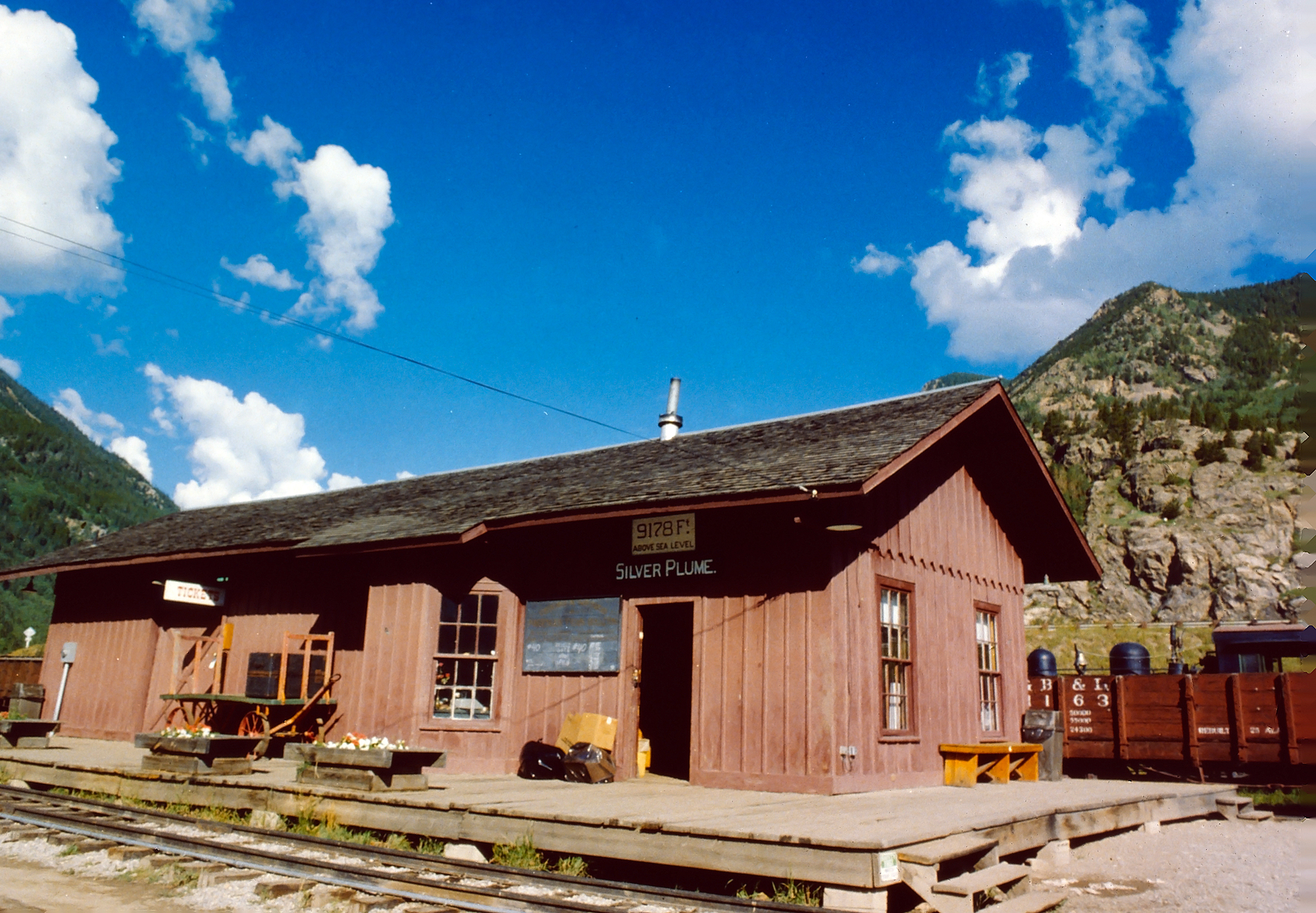 The historic Colorado Central depot in Silver Plume, Colorado; now part of the popular Georgetown Loop Railroad excursion. The structure was built in 1883-1884, and later became part of the Colorado & Southern. American-Rails.com collection.
The historic Colorado Central depot in Silver Plume, Colorado; now part of the popular Georgetown Loop Railroad excursion. The structure was built in 1883-1884, and later became part of the Colorado & Southern. American-Rails.com collection.Henry Hobson Richardson (1838-1886)
Richardson was a prominent architect who studied at Harvard College and Tulane University, later attending the École des Beaux Arts in Paris. He designed many buildings in the U.S. ranging from libraries and homes to churches and commercial structures.
His train stations were largely concentrated in the Northeast where he was commissioned by the Boston & Albany. The architect worked so often in the Romanesque style that a version was named after him, Richardsonian Romanesque.
Jarvis Hunt (1863 - 1941)
While Hunt designed many buildings outside of the railroad industry he has several terminals credited to his name such as Kansas City Union Station, Joliet Union Station, Dallas Union Station, and Union Pacific's headquarters in Omaha, Nebraska.
He often worked in the Beaux Arts style and trained at Harvard University as well as the Massachusetts Institute of Technology' school of architecture.
Link & Cameron
A firm based in St. Louis it included the team of Thomas C. Link and Edward B. Cameron.
Their most famous terminal was the beautiful St. Louis Union Station designed in the French Romanesque style meant to resemble a stunning chateau along the Loire River in France. The facility is fully restored today and a popular city landmark.
Mead, McKim & White
One of the most successful firms throughout the early 20th century, the group was headed by Charles Follen McKim (1847–1909), William Rutherford Mead (1846–1928) and Stanford White (1853–1906).
They are credited with designing numerous buildings across New England, usually centralized around New York City where their business was based.
They were also commissioned for projects across the country and even performed work in Cuba, Italy, and Canada. Their most famous project was Pennsylvania Railroad's iconic Pennsylvania Station in downtown Manhattan.
Reed & Stem
This firm, based in St. Paul, was the partnership of Charles A. Reed (1858–1911) and Allen H. Stem (1856–1931).
They designed numerous passenger terminals, many quite famous and were often commissioned by the Northern Pacific. Notable facilities include Grand Central Terminal (New York), King Street Station (Seattle), Michigan Central Station (Detroit), and Tacoma Union Station.
Renowned Terminals
Main Street Station (Richmond)
Terminal Station (Chattanooga Choo Choo)
Union Stations
Depots
Surviving
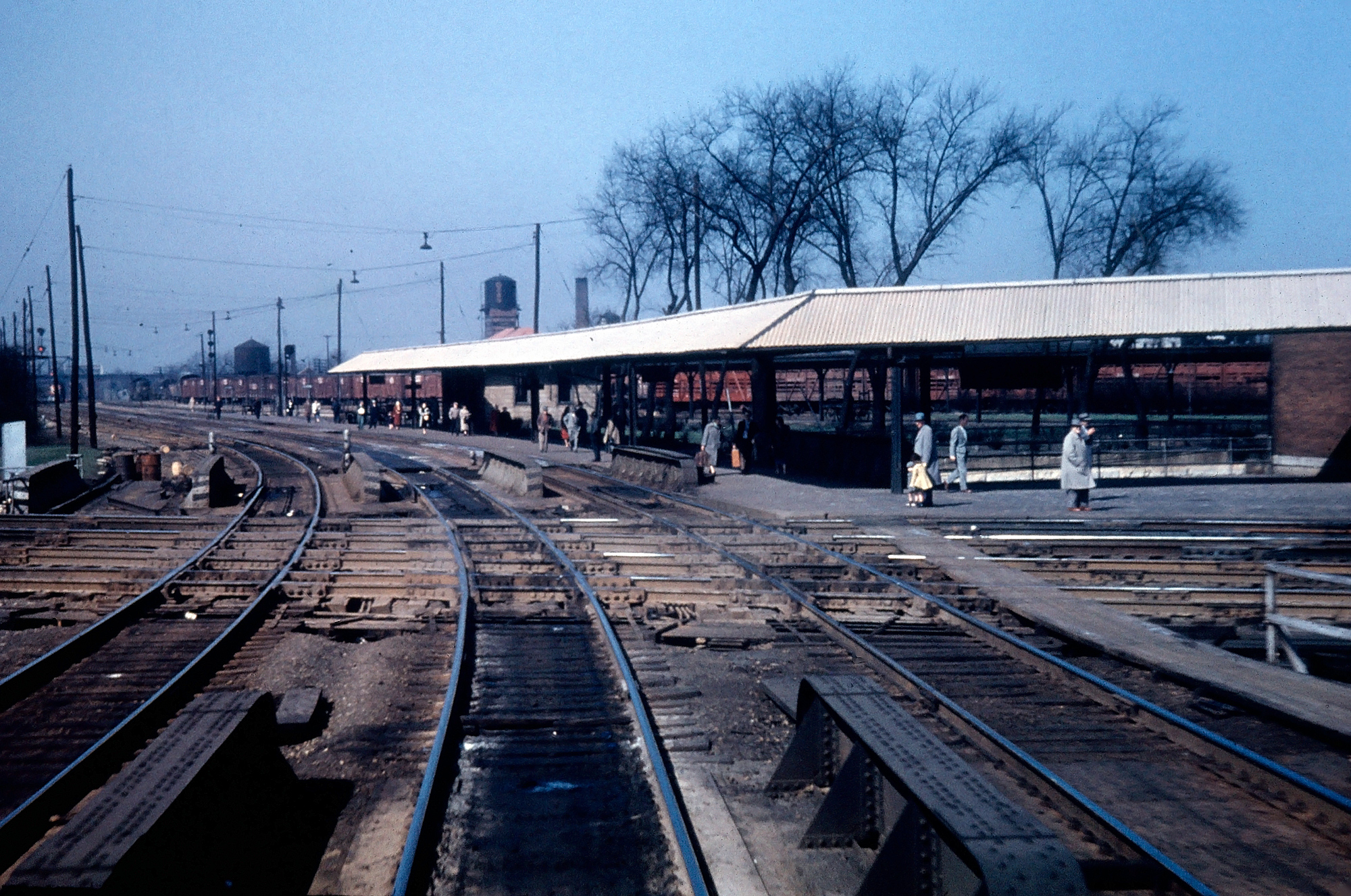 A 1950s view of Englewood Union Station in Chicago. Looking ahead is the Rock Island main line while the Pennsylvania can be seen crossing from left to right. Despite its small size this was a very busy facility for both commuter and long distance trains. It was also used by the Nickel Plate Road and New York Central. A.C. Kalmbach photo. American-Rails.com collection.
A 1950s view of Englewood Union Station in Chicago. Looking ahead is the Rock Island main line while the Pennsylvania can be seen crossing from left to right. Despite its small size this was a very busy facility for both commuter and long distance trains. It was also used by the Nickel Plate Road and New York Central. A.C. Kalmbach photo. American-Rails.com collection.As rail travel faded the demolition of New York's landmark, Pennsylvania Station, truly marked its collapse.
The amazing terminal survived a mere 53 years before a struggling PRR sold the facility's above-ground air rights in 1962; dismantling of the structure began a year later on an overcast October 28, 1963.
While the loss of Penn Station was a significant blow it signaled a poignant change to future preservation efforts; a similar move under Penn Central (PRR's successor) to raze Grand Central Terminal was blocked. The New York City Landmarks Preservation Commission was created by Mayor Robert F. Wagner, Jr. in April of 1965.
It was charged with administering the city's Landmarks Preservation Law and overseeing the protection of historic buildings.
One of its first acts designated nearby Grand Central Terminal a city landmark, sparing it a similar fate. Today, the facility is one of the city's most treasured and visited sites and it still serves as a functioning passenger terminal.
Contents
Depots, Train Stations Or Terminals?
- Beaux Arts
- Chateau
- Colonial
- Gothic
- Greek Revival
- Italianate
- Mission/Mission Revival
- Revival
- Romanesque
- Victorian
- Bradford Lee Gilbert (1853-1911)
- Daniel Hudson Burnham (1846 - 1912)
- Ephraim Francis Baldwin (1837 – 1916)
- Graham, Anderson, Probst & White
- Fellheimer & Wagner
- Francis Hatch Kimball (1845–1919)
- Frank Furness (1839 - 1912)
- Henry Hobson Richardson (1838-1886)
- Jarvis Hunt (1863 - 1941)
- Link & Cameron
- Mead, McKim & White
- Reed & Stem
Recent Articles
-
Washington's Wine Tasting Train Rides
Dec 23, 25 11:45 AM
Here’s a detailed look at where and how to ride, what to expect, and practical tips to make the most of wine tasting by rail in Washington. -
New York Thomas The Train Rides
Dec 23, 25 11:08 AM
These events, part of a national tour, are crafted for young Thomas fans and their families to enjoy an immersive experience filled with adventure, nostalgia, and sheer joy. -
Colorado Thomas The Train Rides
Dec 23, 25 10:55 AM
One of the most picturesque locations to see the beloved Thomas the Tank Engine is Colorado at the Colorado Railroad Museum in Golden.



